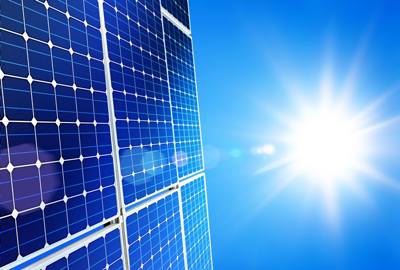
An array of megawatt-scale solar projects are under development in the US, here's a sampling:
General Motors broke ground this week on a $270 million plant expansion in Baltimore to make electric vehicle components. A 1.23 MW rooftop solar system is expected to provide 9% of the facility's annual energy consumption and save approximately $330,000 over the life of the project .
Constellation Energy (NYSE: CEG) will build, own and maintain the solar system, and GM will purchase the electricity output under a 20-year agreement.
The Baltimore Operations Complex, which houses GM's two-mode hybrid and heavy-duty transmission operations, is already a relatively green facility, having achieved net-zero landfill status in 2007. Now the facility will add electric motor design and production.
GM also announced it will boost production of its flagship plug-in hybrid – the Chevy Volt – to 60,000 units in 2012. That's up from 16,000 units this year. GM says 45,000 of the vehicles will be sold in the US.
The Volt launched in select US states at the end of 2010, and will be available nationwide and in Europe, China and Canada by the end of this year.
General Electric is also making greater use of rooftop solar. The company is putting 9,000 solar panels on a GE Aviation plant in Durham, North Carolina, that makes jet and turboprop engines and components.
The $3 million rooftop system will cover roughly 7 acres and have a capacity of 2.4 MW. It will be the largest rooftop solar system owned by GE.
Community Energy Solar is building Pennsylvania's largest solar system in Lancaster County, Pennsylvania. Output from the 6 MW system will be sold to Exelon (NYSE: EXE) under a 15-year power-purchase agreement.
The system will consist of approximately 25,000 solar panels on 30 acres and create an estimated 75 solar energy jobs during construction.
Western Massachusetts Electric Company is developing a 2.2 MW solar array in Springfield, Massachusetts. The site – owned by the Springfield Redevelopment Authority – encompasses 12 acres and will accommodate 8,200 solar panels.
The project will bring $12 million in construction contracts to the region and is expected to contribute $400,000 in annual property tax revenue to the City of Springfield.
Tioga Energy has begun development of 44 solar energy systems with a combined capacity of 3.4 MW at facilities owned by a variety of local government agencies in Union County, New Jersey. Tioga will own and operate the projects, selling the electricity generated back to the county at predictable rates and lowering electricity costs by approximately 50% over 15 years.
To finance the installations, Tioga Energy and the Union County Improvement Authority combined low-interest municipal bonds with the sale of solar renewable energy certificates (SRECs) and federal tax incentives.
The 44 solar electric systems will be located at a variety of county-owned sites, including three firehouses, four libraries and schools in seven districts.
San Diego Gas & Electric (SDG&E) signed two additional 25-year contracts with subsidiaries of Soitec Solar Development, LLC for a total of 125 MW of solar energy.
The southern California solar plants will use Soitec's Concentrix concentrating photovoltaic technology (CPV) manufactured in a new factory to be built in the San Diego area.
These new agreements are separate from the three San Diego contracts the two companies signed in April for 30 MW of CPV-generated solar power. Combined, the five contracts SDG&E recently signed with Soitec are for five separate projects capable of generating a combined total of 155 MW of solar.
Soitec's new manufacturing facility will have an annual production capacity of 200 MW. At full capacity, Soitec's San Diego operations facility will generate up to 450 direct clean energy jobs and more than 1,000 indirect jobs. The factory location is expected to be announced this summer, with completion within 18 months of construction start.
SunPower (Nasdaq: SPWRA) is designing and building a 4MW solar array that will be part of the largest planned zero-net energy development in the US.
The development is a residential village at the University of California, Davis. It will include solar panels on rooftops and parking canopies, supplying 100% of the power needs for student housing, recreation and study facilities.
The UC Davis West Village project is the product of a public-private partnership between UC Davis and West Village Community Partnership, LLC, a joint venture led by San Francisco-based Carmel Partners with their partner Urban Villages of Denver.

